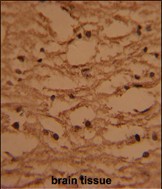HTATSF1 Antibody (N-term)
Affinity Purified Rabbit Polyclonal Antibody (Pab)
- 产品详情
- 实验流程
- 背景知识
Application
| WB, IHC-P, E |
|---|---|
| Primary Accession | O43719 |
| Other Accession | Q8BGC0 |
| Reactivity | Human |
| Predicted | Mouse |
| Host | Rabbit |
| Clonality | Polyclonal |
| Isotype | Rabbit IgG |
| Calculated MW | 85853 Da |
| Antigen Region | 1-30 aa |
| Gene ID | 27336 |
|---|---|
| Other Names | HIV Tat-specific factor 1, Tat-SF1, HTATSF1 |
| Target/Specificity | This HTATSF1 antibody is generated from rabbits immunized with a KLH conjugated synthetic peptide between 1-30 amino acids from the N-terminal region of human HTATSF1. |
| Dilution | WB~~1:1000 IHC-P~~1:100~500 E~~Use at an assay dependent concentration. |
| Format | Purified polyclonal antibody supplied in PBS with 0.09% (W/V) sodium azide. This antibody is prepared by Saturated Ammonium Sulfate (SAS) precipitation followed by dialysis against PBS. |
| Storage | Maintain refrigerated at 2-8°C for up to 2 weeks. For long term storage store at -20°C in small aliquots to prevent freeze-thaw cycles. |
| Precautions | HTATSF1 Antibody (N-term) is for research use only and not for use in diagnostic or therapeutic procedures. |
| Name | HTATSF1 {ECO:0000303|PubMed:35597237, ECO:0000312|HGNC:HGNC:5276} |
|---|---|
| Function | Component of the 17S U2 SnRNP complex of the spliceosome, a large ribonucleoprotein complex that removes introns from transcribed pre-mRNAs (PubMed:30567737, PubMed:32494006, PubMed:34822310). The 17S U2 SnRNP complex (1) directly participates in early spliceosome assembly and (2) mediates recognition of the intron branch site during pre-mRNA splicing by promoting the selection of the pre-mRNA branch- site adenosine, the nucleophile for the first step of splicing (PubMed:30567737, PubMed:32494006, PubMed:34822310). Within the 17S U2 SnRNP complex, HTATSF1 is required to stabilize the branchpoint- interacting stem loop (PubMed:34822310). HTATSF1 is displaced from the 17S U2 SnRNP complex before the stable addition of the 17S U2 SnRNP complex to the spliceosome, destabilizing the branchpoint-interacting stem loop and allowing to probe intron branch site sequences (PubMed:32494006, PubMed:34822310). Also acts as a regulator of transcriptional elongation, possibly by mediating the reciprocal stimulatory effect of splicing on transcriptional elongation (PubMed:10454543, PubMed:10913173, PubMed:11780068). Involved in double-strand break (DSB) repair via homologous recombination in S- phase by promoting the recruitment of TOPBP1 to DNA damage sites (PubMed:35597237). Mechanistically, HTATSF1 is (1) recruited to DNA damage sites in S-phase via interaction with poly-ADP-ribosylated RPA1 and (2) phosphorylated by CK2, promoting recruitment of TOPBP1, thereby facilitating RAD51 nucleofilaments formation and RPA displacement, followed by homologous recombination (PubMed:35597237). |
| Cellular Location | Nucleus. Chromosome Note=Recruited to DNA damage sites during S-phase following interaction with poly-ADP-ribosylated RPA1. |
| Tissue Location | Widely expressed.. |
For Research Use Only. Not For Use In Diagnostic Procedures.
Provided below are standard protocols that you may find useful for product applications.
BACKGROUND
HTATSF1 functions as a cofactor for the stimulation of transcriptional elongation by HIV-1 Tat, which binds to the HIV-1 promoter through Tat-TAR interaction. This protein may also serve as a dual-function factor to couple transcription and splicing and to facilitate their reciprocal activation.
REFERENCES
Miller,H.B., PLoS ONE 4 (5), E5710 (2009)
Remoli,A.L., Biochem. J. 396 (2), 371-380 (2006)
终于等到您。ABCEPTA(百远生物)抗体产品。
点击下方“我要评价 ”按钮提交您的反馈信息,您的反馈和评价是我们最宝贵的财富之一,
我们将在1-3个工作日内处理您的反馈信息。
如有疑问,联系:0512-88856768 tech-china@abcepta.com.
|
Anonymous
2016-08-24 09:20:44
1
2
3
4
5
|
Species tested
Mouse,Rat
Application tested
WB
Organization tested
NIH/3T3,Liver(M),Kindey(M),Liver(R)
Barcode encoding
Brief protocol
1. Block with 3% skim milk for 1 hour at room temperature.
2. Incubate overnight with Abgent primary antibody 1:1000 in 3% skim milk at 4℃
3. Wash 5*5 min with TBST.
4. Incubate with HRP-conjugated secondary antibody 1:5000 in 3% skim milk for 1 hour at room temperature.
5. Wash 5*5 min with TBST.
6. Incubate with ECL substrates and expose
|























 癌症的基本特征包括细胞增殖、血管生成、迁移、凋亡逃避机制和细胞永生等。找到癌症发生过程中这些通路的关键标记物和对应的抗体用于检测至关重要。
癌症的基本特征包括细胞增殖、血管生成、迁移、凋亡逃避机制和细胞永生等。找到癌症发生过程中这些通路的关键标记物和对应的抗体用于检测至关重要。 为您推荐一个泛素化位点预测神器——泛素化分析工具,可以为您的蛋白的泛素化位点作出预测和评分。
为您推荐一个泛素化位点预测神器——泛素化分析工具,可以为您的蛋白的泛素化位点作出预测和评分。 细胞自噬受体图形绘图工具为你的蛋白的细胞受体结合位点作出预测和评分,识别结合到自噬通路中的蛋白是非常重要的,便于让我们理解自噬在正常生理、病理过程中的作用,如发育、细胞分化、神经退化性疾病、压力条件下、感染和癌症。
细胞自噬受体图形绘图工具为你的蛋白的细胞受体结合位点作出预测和评分,识别结合到自噬通路中的蛋白是非常重要的,便于让我们理解自噬在正常生理、病理过程中的作用,如发育、细胞分化、神经退化性疾病、压力条件下、感染和癌症。








